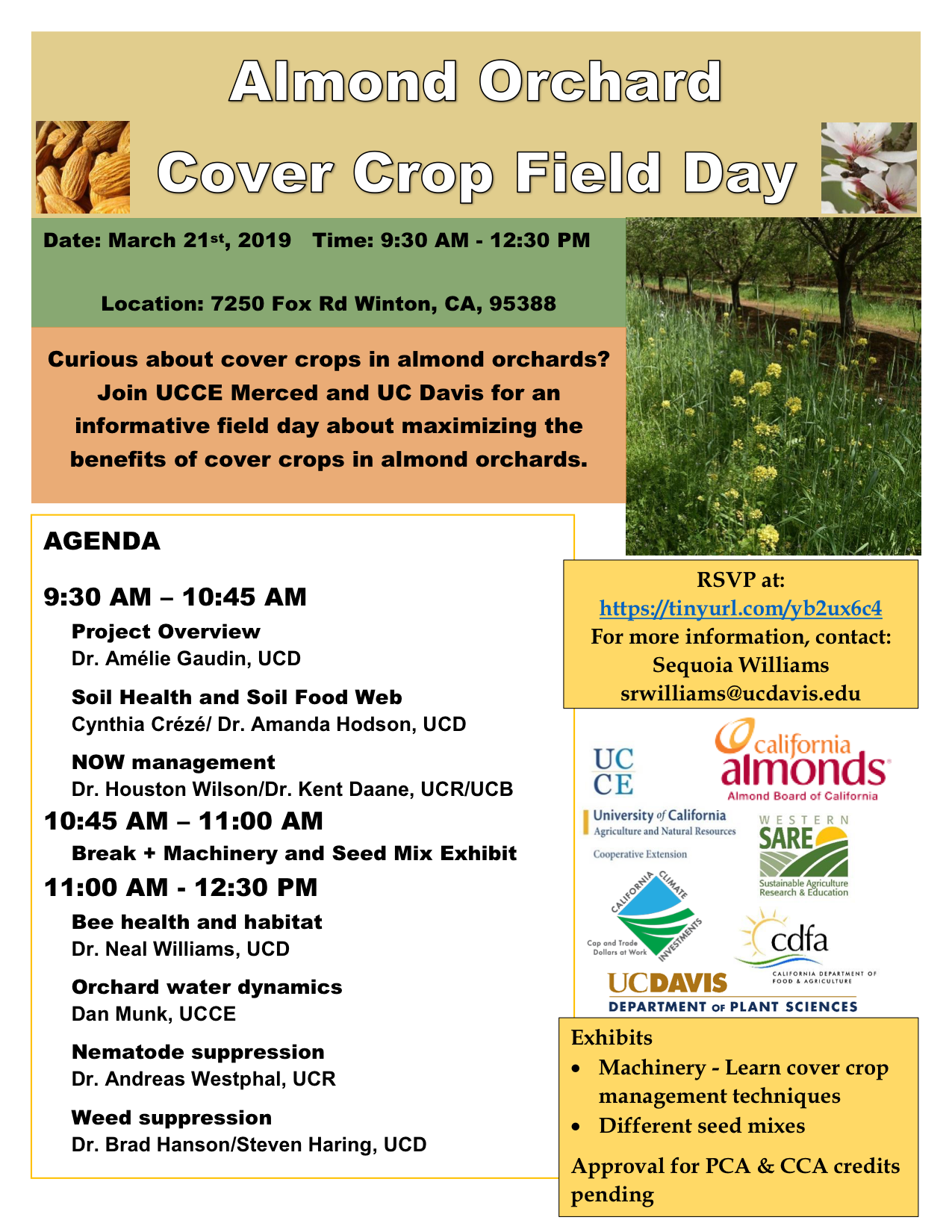Progress report for GW18-142
Project Information
With a total crop values of $5 billion, almond (Prunus dulcis) is one of California’s most important crops. Almond production is faced with multiple challenges, many of which are related to soil degradation. Based on the recent Almond Board of California Sustainability Survey, there has been a shift in growers’ soil management practices away from the conventional bare soil management towards maintaining a resident vegetation soil cover throughout the winter. This change was in response to increasing concerns regarding impact of poor soil health on tree productivity, and the increased interest to sequester carbon and reduce the environmental footprint of almond production. Short-term studies conducted in the 1990s showed that cover cropping was compatible with intensive almond production systems. However, this practice was never widely implemented due to remaining concerns regarding possible tradeoffs and lack of cover crop best management practices (BMPs).
To address these uncertainties, my project is first conducting a state-wide growers' survey to identify barriers, which have hampered cover crop adoption in California, and to understand the early adopters' motivations and management practices. In addition, three replicated, randomized experiments have been established in 2017 in growers’ orchards across California’s soil-climate gradient to assess the impact of two cover crop mixes and termination dates on soil health. The two multi-species cover crop mixes were designed to address key grower objectives (pollinator habitat and soil health). The project is integrated within a larger system-wide initiative in collaboration with other UC Davis research teams evaluating multiple co-benefits and potential tradeoffs of cover cropping on ecosystem services (pollinator health, soil food web support, weed management, parasitic nematode suppression and water conservation). This will provide growers with a comprehensive opportunity cost assessment and support the development and adoption of sustainable soil management practices.
Objective 1. Compile knowledge on the use, management and barriers for the adoption of cover crops in irrigated almond orchards.
Objective 2. Determine the potential of two cover crop mixes to enhance soil health across a soil-climate gradient.
Objective 3. Determine how cover cropping management can be integrated in almond orchards to address specific soil-related issues.
a. Orchard trial 1. Compaction study. Determine the capacity of cover cropping to restore and maintain soil quality and structure at a compacted site compared to deep ripping.
b. Orchard trial 2. Termination study. Determine how cover crop termination timing affects nitrogen fixation, and C:N dynamics in orchard soils.
c. Orchard trial 3. Nitrogen study. Determine the effect of cover cropping on nitrogen cycling in orchard systems.
Objective 4. Evaluate the performance of each cover crop species mixture through an ecosystem service assessment to weigh the benefits to tradeoffs of cover cropping.
Objective 5. Extend information and communicate results to growers on the potential of cover cropping to augment ecosystem services in almond orchards, through workshops and grower field days.
Objective 6. Contribute to the scientific body of knowledge related to sustainable agriculture by publishing the outcomes of objectives 1-4 in peer-reviewed journals.
Cooperators
Research
Growers' Survey (Obj. 1).
Survey design.
A questionnaire was designed in 2017 following the Tailored Design Method (Dillman et al., 2009) and using Qualtrics©, a cloud-based survey software. Questions were chosen to meet four main objectives. Firstly, the questions provided insight on currently used floor management practices across the landscape and their respective popularity amongst users. Second, they identified potential barriers respective to either (1) ecosystem tradeoffs, which could offset short-term agronomic productivity or (2) the practicality of integrating cover cropping (CC) operations in almond orchard systems. Thirdly, the survey determined motivators of non-users (perceived benefits) and of current users (perceived benefits and realized benefits following implementation). Finally, the survey determined current gaps in knowledge and information, which producers may need to build their understanding of CC.
Survey respondents.
The target group of respondents are individuals involved in the decision-making process of almond farms: owners, managers and/or operators. Respondents of the survey were asked to identify themselves as either users or non-users of cover crops, each of which then followed different questionnaires. Questions addressed to both users and non-users identified perceived benefits and concerns associated with cover cropping. The questionnaire addressed specifically to users included questions relating to their experience with cover crops (types of crops grown, proportion of the land with CC, annual or perennial, winter or spring, single or multi-species mix) and to their management practices (seeding date and date of termination). The definition of users specified in the survey was: “growers having cover crops grown on either part or all of their acreage with a minimum of 1 acre, in at least one growing season in the past five years”. The target group of respondents did not include external farm advisors nor extension specialists.
Survey distribution.
An IRB human subject’s approval was obtained for this study for the graduate student and PI. The survey questions were communicated to the Almond Board of California (ABC) and approved for distribution in December 2017. The paper-version of the survey was distributed at the 2017 & 2018 & 2019 Almond Board of California Annual Conference. An online version was also made available through the project website (https://almondcovercrop.faculty.ucdavis.edu). Paper-versions of the survey were distributed through UCCE Extension Centers at almond-specific growers' workshops and outreach events. The survey was also communicated through the Western Farm Press, RCDs and UCCE County Newsletters. Ultimately, the information drawn from this survey will be used to tailor research agendas respective to the evaluation of cover-cropping systems and to bring relevant and applicable information that address growers' interests.
Growers' Survey URL: https://almondcovercrop.faculty.ucdavis.edu
Field Study (Obj. 2 & 3).
Cover Crop Design.
Two cover crop mixes were designed for this project: a Pollinator mix (PM) and a customized Soil Building mix (SM) as indicated in Table 1. The pollinator mix is currently the most popular cover crop mix in almond orchards (Pam Mustard Mix, Project Apis). The PM is composed primarily of flowering mustard species to attract bees and provide a habitat. Species in this mix come to bloom relatively quickly and can provide flowers from November to February attracting bees within the orchard prior to and during almond bloom. The PM has previously been recommended by the Almond Board in 2016 and has gained popularity with almond growers. However, no comprehensive study has been conducted to analyze the performance of this mix, relative to different ecosystem services. The Soil Building mix is designed to address soil-related issues and develop overall soil health whilst limiting water demand. The SM was developed based on the USDA-ARN Cover Crop Chart (v.2.1) evaluation (Johnson et al., 2015). Species were selected from three plant families (brassica, grass and legume families) to provide diverse rooting architectures and nutrient cycling characteristics. Least relative water-consumptive plant species in each family were chosen. White mustard was kept as a standard between the PM and SM, to ensure both mixes provide services to bees and to provide biofumigant potential through the production of isothiocyanates by white mustard. The capacity of both mixes with regards to both aspects will be compared. Furthermore, Daikon radish as a tuberous crop was be kept in both mixes to address challenges pertaining to soil compaction and water infiltration, which have been identified as key issues in almond orchards. Finally, the SM plant species were selected based on the relative price of seed ($1.25 per pound or $62.5 per acre). Including native California flowering species nearly tripled the price of the mixes: therefore, for the purpose of this study, native species were not selected. Finally, mix design considered the seed availability throughout the season, and its accessibility in different regions of CA, to limit cover cropping transition costs. The PM and SM likely impact soil health, and C and N retention differently. The cover crop mixes were compared to resident vegetation at each of the sites and to bare, chemically-controlled floor management.
Table 1. Cover crop mix composition (% weight) and seeding rate (lbs./acre)

Field Replicated Trials.
We established three randomized complete block design (RCBD) trials with four replications (3 tree rows x 4 treatments x 4 blocks). A total of three sites have been chosen in three ecoregions of California: Tehama county in the Sacramento Valley, Merced county in the northern San Joaquin Valley, and Kern county, in the southern San Joaquin Valley. All orchard sites were clay loam to sandy clay loam with 50% Nonpareil on Nemaguard rootstocks with microsprinkler irrigation. Each orchard was a minimum of 4 acres (final range of 8-40 acres) including floor management treatments: winter planted cover crops – a pollinator mix and a soil building mix, winter resident vegetation and chemically-controlled bare soil. Cover crop mixes were seeded following almond harvest from October to November in each season and terminated from March to May. A key challenge for bearing orchards was finding compatible seeders to allow for wide seeding of the cover crop whilst avoiding damage to the tree branches. To do so, we used compact seeders of 6-15 feet width and ran several passes (Figure 1). Resident vegetation plots were mowed and maintained to provide a continuous ground cover. Bare soil plots were chemically-controlled according to conventional practices.
Figure 1. Seeders used in this study (a) Schmeiser Compact No-Till Cover Crop Drill, (b) John Deere 750 No-Till grain drill and (c) Great Plains No-Till Seeder NTS2511

Orchard-specific studies.
In line with regional survey results, we designed four orchard-specific cover crop studies to address regional knowledge demands. At our first and southern-most site, we included a ripping treatment to compare its effect on soil health compared to that of cover crops. At our first and second sites, we studied the effect of different cover crop termination times on soil health shifts. At our third and northern-most site, due to considerable regional concerns on frost damage, we decided to focus our study on cover crop effects to heat transfer and frost incidence in the orchard microclimate.
Orchard Site 1. Compaction Study (Obj. 3).
The southern-most site included a ripping treatment to compare this practice’s capacity to remediate soil compaction as compared to cover cropping. Orchard middles were ripped in fall 2017 using a Schmeiser mid-row ripper. Ripping depth was set at approximately 60 cm with a width of 15 cm at approximately 1.5 m from the tree rows. The middles were not be ripped in subsequent years.
Figure 2. Kern county Orchard. Experimental design including two cover crop mixes and ripping treatments
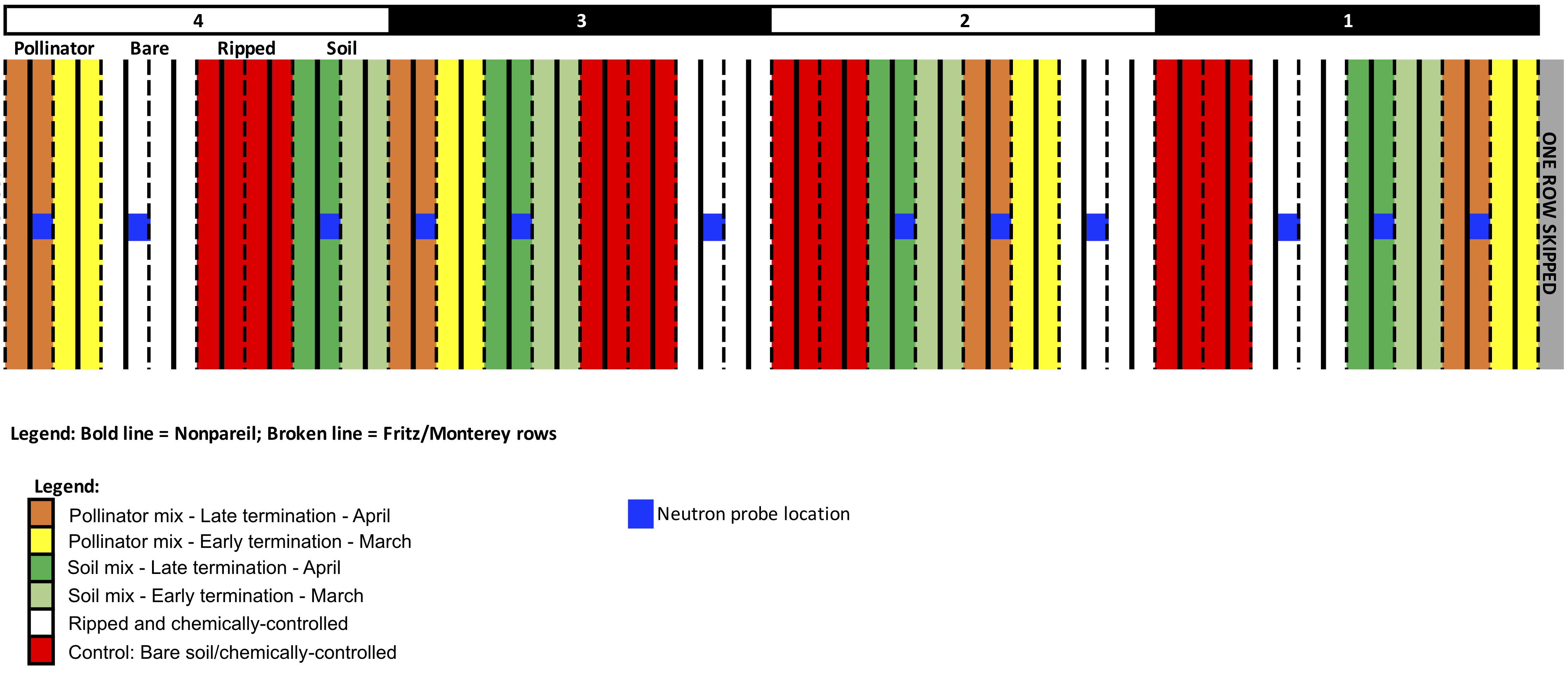
Orchard Site 1 & 2. Termination & Nitrogen Study (Obj. 3).
Two termination methods of the cover crop were compared: an “early termination” in late-February to mid-March and a “late termination” in April. The cover crop middles were flail-mowed followed by a chemical-herbicide application approximately 1-week following mowing. Cover crop residues were left at the surface on the orchard middles. Separate cover crop biomass samples were collected prior to each termination and dry weights were measured. The dry samples were ground to the consistency of a fine powder and analyzed for total N and C for each sampling event, to record the composition of the residue returned to the orchard.
Figure 3. Merced County Orchard. Experimental design including two cover crop mixes and termination treatments
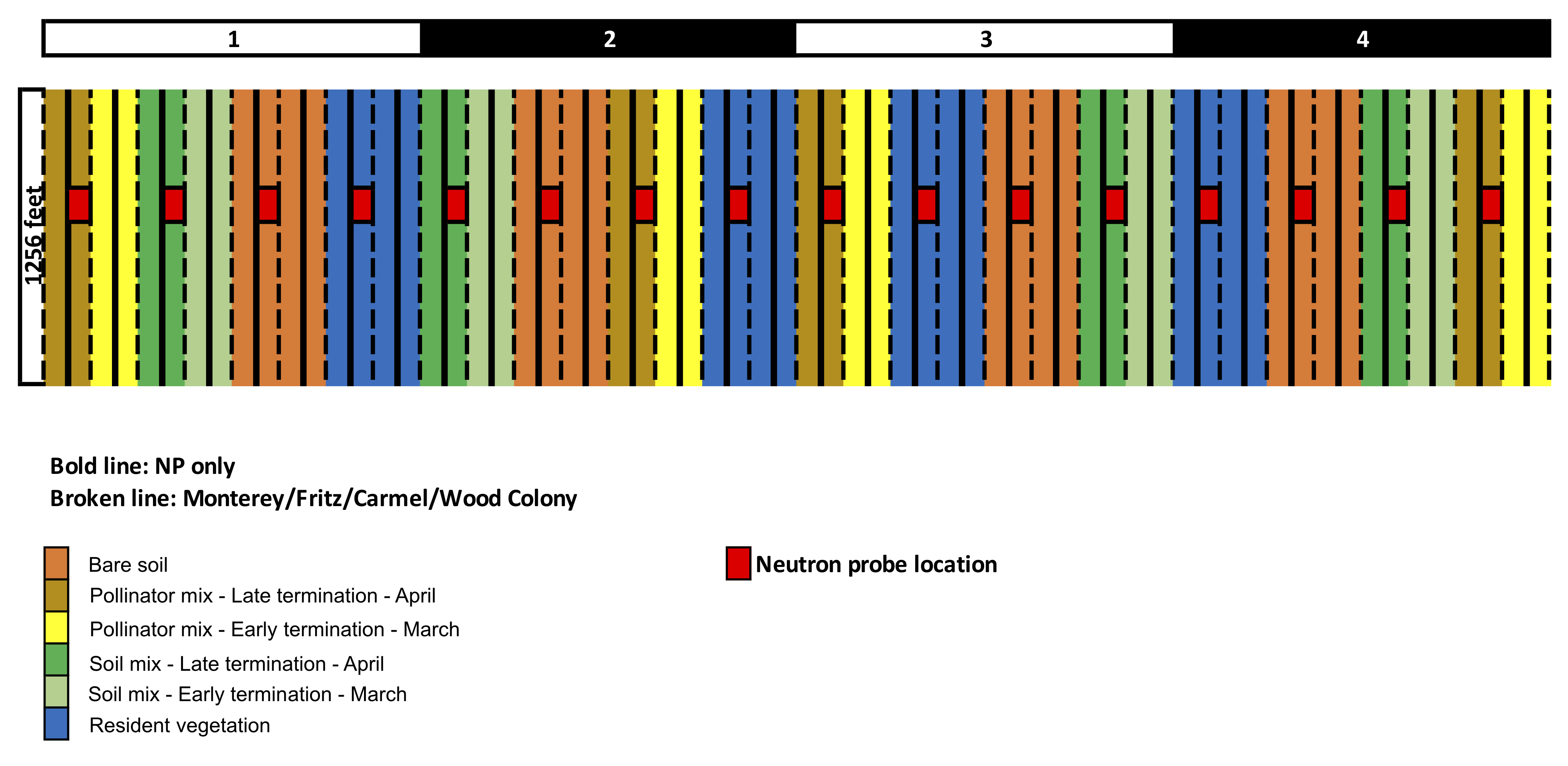
Orchard Site 3. Frost Study.
Due to considerable regional concerns on frost damage, we decided to focus the site-specific study of our northern-most site on cover crop effects on heat transfer and frost incidence in the orchard microclimate. We monitored top-soil temperatures at a 6 cm depth using ECH20 5TE sensors (Meter group) connected to EM50 dataloggers. Soil ECH20 5TE sensors also provided readings of soil volumetric water content (%) and EC throughout the winter. Diurnal orchard temperatures and relative humidity (%) were recorded using HOBO Pro-v2 loggers (Onset corp.) set at 5 cm above the soil surface, 90 cm (3 feet) and 150 cm (5 feet), which corresponded to the mid-tree canopy height. Finally, to monitor cover crop canopy development and growth rates throughout the winter, we used NDVI/PRI spectral reflectance sensors (Decagon corp.).
Figure 4. Tehama County Orchard. Experimental design including two cover crop mixes and frost-monitoring stations
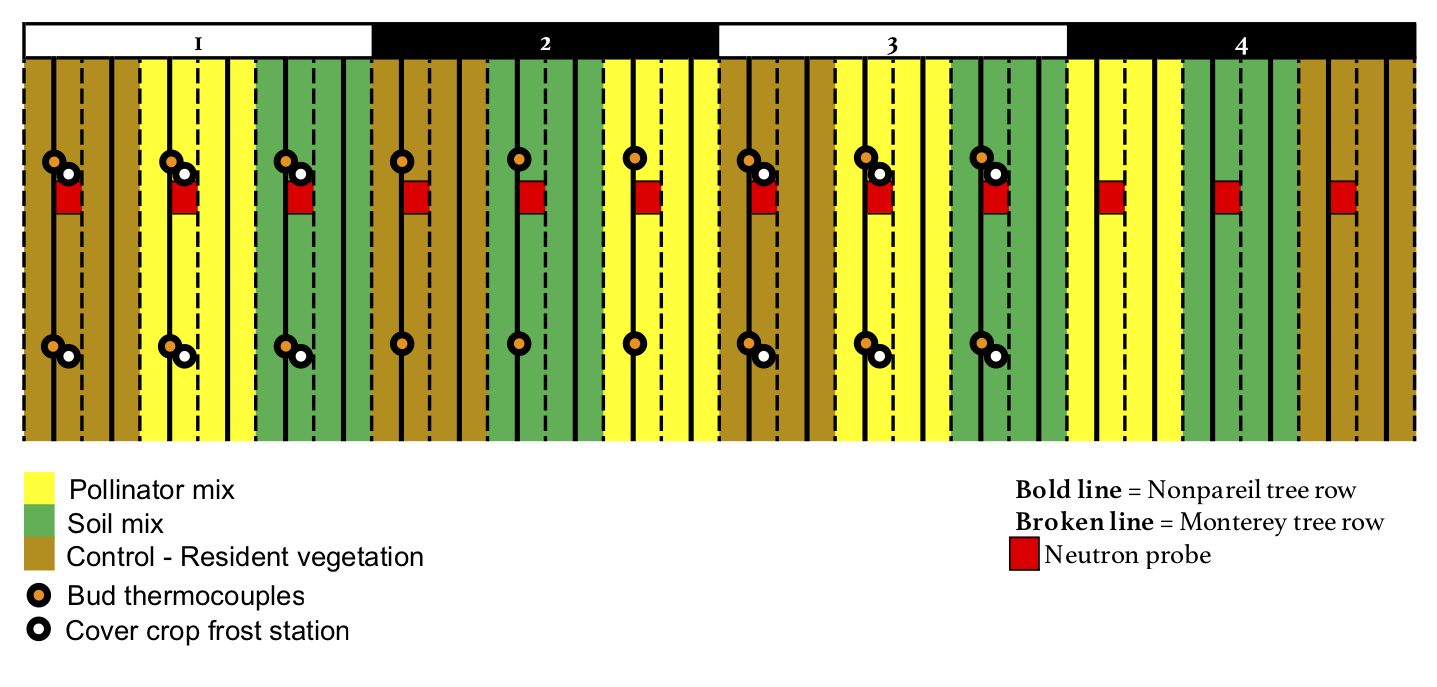
Soil sampling and analyses
Baseline soil samples were collected prior to cover crop seeding in October 2017. Post-cover crop soil samples were collected in October 2018. For the second year of the trial, soil samples were also collected during cover crop development in February and within 1-2 weeks of termination at each site. In each plot, samples (0-15 cm) were taken from the alleyways and at the border of the cover crop nearest to the NonPareil tree berm. Baseline samples were analyzed for chemical properties (pH, soluble salts, OM%, Total C, Sum of Cations (CEC), K, Ca, Mg, Na, S, Olsen P, nitrate and ammonium content and total N) and physical properties (texture, bulk density). Post-treatment soil analyses also included microbial biomass carbon (MBC), microbial biomass nitrogen (MBN) and labile C using the PoxC method as well as aggregate size distribution and stability. In-situ measurements of water infiltration were taken using a Decagon Dual-Heal infiltrometer at baseline and post-treatment in October 2018. Samples were also used to assess soil food webs and the beneficial nematode populations by our collaborator (Hodson, A.).
Cover crop sampling and laboratory analyses.
Total cover crop biomass as well as species composition and relative abundance and separate C:N ratio for each species were collected from a 0.25 m2 area within each plot before each mowing event and each termination. Dry biomass was determined after drying at 60°C to a constant weight. The dry samples were ground to the consistency of a fine powder and analyzed for total N and C.
Almond yields.
At each experimental site, yield production was collected and weighed per treatment replicate. At the northern-most site, manual polling was conducted to remove all almonds from three individual trees per treatment replicate. Yields were brought to UC Davis, hulled and dried to obtain final kernel dry weights. Mechanical harvesters were used at the other two sites. At both sites, conditioners were used to remove residues from the yields. Yields were piled in rows and left to dry approximately a week prior to hulling and kernel weight measurements.
Ecosystem service assessment (Obj. 4).
In parallel to soil health analyses, other orchard ecosystem services were assessed including pollinator habitat and visitation, parasitic nematode abundance, beneficial nematode abundance, navel orangeworm (NOW) survival and weed pressure. As a part of this study, a full ecosystem assessment of cover crop effects on almond production will be conducted. A multivariate system analysis will be conducted to weigh benefits to tradeoffs as affected by orchard floor management to define best management practices, which optimize benefits for both the producer and the environment.
References:
Dillman, D.A., Smyth, J.D., & Christian, L.M. (2009) Internet, mail, and mixed-mode surveys: The tailored design method, 3rd ed. Hoboken, NJ: John Wiley & Sons, Inc.
Johnson, H and M. Liebig. 2015. Cover Crop Chart. USDA-ARS Northern Great Plains Research Laboratory. Mandan, MD.
Growers’ survey
Of a total of 174 responses, 90 passed the quality check process, all of which were online surveys. This represents an estimated 5% response rate following distribution efforts. Of respondents, 55% reported using cover crops in their orchards and 58% used organic matter amendments, with a significantly greater probability of growers to use cover crops, if they were using organic amendments (Fisher’s exact test, P=0.01). Regardless of categorical group (cover crop usage, geographical location or farm size), all respondents recognized that cover cropping in almond orchards presents potential benefits. Across all groups, growers’ primary interest was directed towards agronomic benefits (i.e., increased organic matter, reduced dust), as opposed to operational (i.e., earlier field access) or economic gains (i.e., reduced input expenses, positive economic return). Growers’ greatest interest was for (1) soil structure and field access, (2) soil health, (3) pollinator habitat, (4) water infiltration and retention. Our data suggest that lack of perceived benefits is not a barrier to cover crop adoption.
Most early adopters in this survey reported using cover crop mixes of four species or more. Brassica and legume plant species were the most frequently used, followed by grass species. Although 84% of growers indicated that cover cropping met their expectations, 16% reported having discontinued cover cropping due to important barriers. The majority of growers, who discontinued the practice reported germination difficulties. However, none of the respondents reported cover crop incompatibility with other orchard operations (i.e. sanitation, frost control) as a cause for discontinuing the practice. In fact, 64% of growers reported conducting pruning of their orchard after cover crop seeding and 62% crush or flail-mow mummies in their cover crop during the winter. 32% of growers reported that they do not terminate the cover and that this does not create complications at harvest: the cover is left to reseed and dies naturally during the summer due to lack of water. Only 39% of growers irrigated the cover crop, suggesting most growers do not incur supplemental water costs with cover cropping.
Non-users of cover crops ranked economic concerns as 10x more important, than adopters, but also ranked the lack of available information on cover crops as twice as important as for adopters (P=0.001). Results (n=121) of our survey suggest a potential link between region-dependent water costs and cover crop adoption within the Central Valley. The Sacramento Valley benefits from a more ample water supply than the San Joaquin Valley, due to higher annual precipitation and greater provision of surface water through the Sacramento River flow. With reduced water costs, our study recorded significantly less concerns over cover crop transition in the Sacramento Valley compared to the San Joaquin Valley (P=0.02). Growers of the Sacramento Valley were also less concerned about potential frost control complications with cover cropping (P=0.04). In almond ecosystems, conventional frost freeze protection uses irrigation, to facilitate heat transfer in the orchard. These results suggest a need for both clear cost-benefit assessments of cover cropping under different farm scale scenarios, but also a need to address agronomic and operational concerns through the development of best management practices, which would account for different water cost contexts relevant to regions of California.
Overall, our results suggest that reluctance to adoption are driven by concerns of tradeoffs, rather than lack of potential gains. Our data reveal distinct objectives for cover cropping, which differ by farm size and amongst regions of California.
Field Study
Cover crop biomass and performance
Despite identical seeding rates and mixes, the species-composition of the cover crop varied widely by location and year, which likely implies differences in functionality and plant-soil feedback potential, as suggested by the important variation in C:N content of the biomass. For example, the soil mix was composed of 60% mustard in Corning whereas it was composed of 59% ryegrass in Merced. The elemental composition of the cover also shows high season and site-dependency with the C:N ratio of the soil mix varying from 7:1 to 13:1, which may affect cover crop outcomes.
The two seasons of data indicate that biomass production was not proportional to precipitation regimes. Across sites, total annual precipitation doubled from 2018 to 2019. Yet, total biomass produced decreased in 2/3 sites, with ryegrass showing more adaptability to heavy precipitation than mustards. Whereas the seeded cover crop produced 180-312% more biomass than resident vegetation in 2018, with higher winter precipitation in 2019, there was similar biomass production between the treatments in 2019. Highest cover crop productivity was obtained at 200-300 mm/year whereas ranges of 130-180 mm/year and 400-700 mm/year yielded less biomass. Due to varying capacity to suppress weeds by season and site, the cover crop mixes had varying proportions of resident vegetation in its cover. The cover crop stands contained more resident vegetation in Merced than in Tehama and Kern county sites. Overall, Merced ryegrass and mustards had a stronger establishment in the orchards compared to Hairy vetch and PK Berseem clover. Groundcover was not proportional to biomass production. Despite its lower biomass production in 2018, resident vegetation provided a similar groundcover as the cover crop, indicating its potential for erosion control.
Therefore, the functional traits of the seeded cover crop were not consistent across site and season. This must be considered when developing seed mixes and selecting cover crop species for a particular purpose in an orchard. Our results highlight the need to further develop region-specific BMPs for almond cover cropping in California.
Figure 5. Left: Pollinator mix (1 family/5 species), Right: Soil building mix (3 families/5 species)
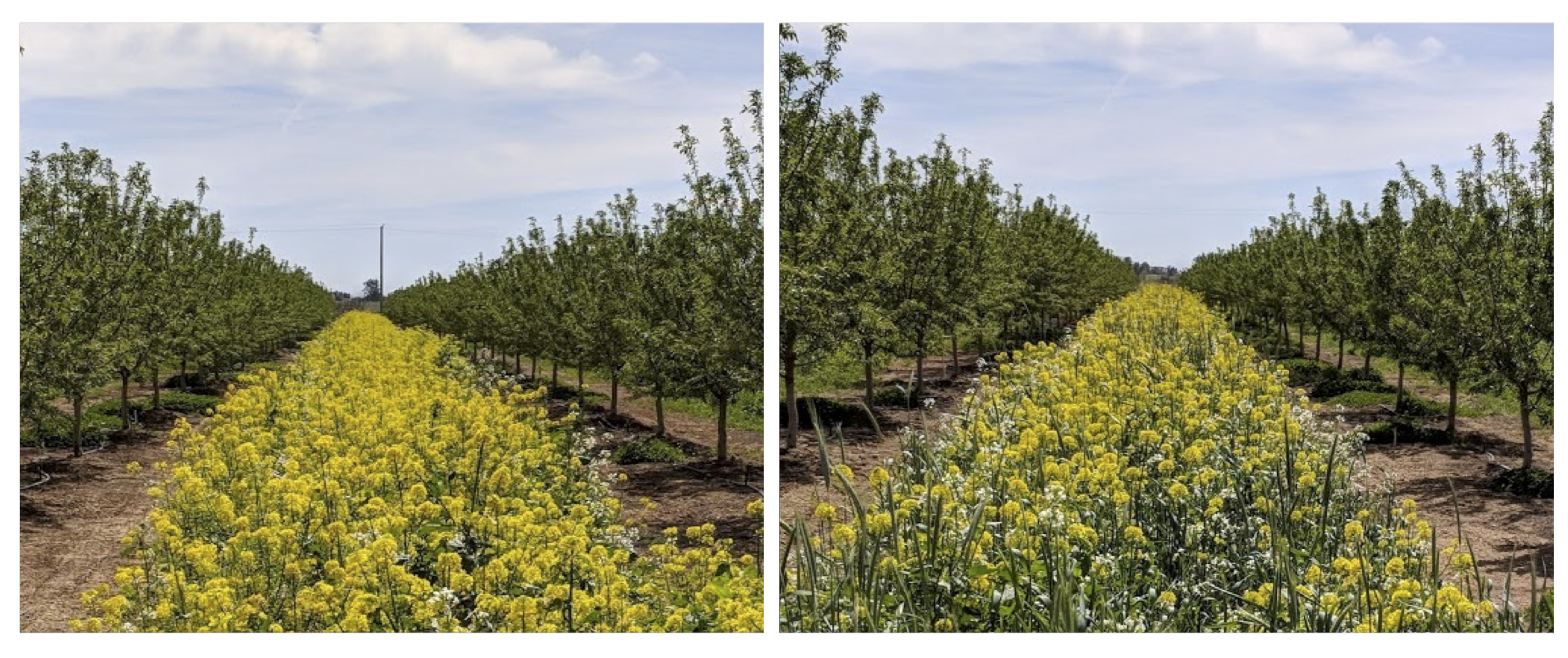
Frost Study.
This study was conducted at the Tehama site, where frost risks were most severe. During a critical time period for orchard frost damage, we found that orchard temperatures dropped below -2°C, regardless of vegetative cover type (cover crop or resident vegetation). Vegetative covers had important differences in canopy development at that time: resident vegetation had approximately 25% higher ground coverage in February 19th-28th whereas it had 66% and 60% less biomass per ground-surface area compared to the pollinator and soil mixes, respectively. No irrigation for frost protection was applied to the orchard.
Cooler soil temperatures were found in the cover cropped plots, suggesting cover cropping acted as a barrier to heat transfer in the orchard. However, there was no effect on ambient air temperatures at 3 and 5 feet aboveground. These results suggest that cover cropping in orchards may not increase frost risks in almond orchards. These findings contributed to the extension article available at http://cetehama.ucanr.edu/newsletters/Fruit_-_Nut_Newsletters76786.pdf (Lightle, Crézé & Gaudin, 2018). As these results are based on one season of data, further research would need to be conducted to assess this potential tradeoff of cover cropping in almond orchards.
Figure 6. (Left) Frost stations installed in the orchard to measure topsoil temperature and air temperatures at 2 inches, 3 feet and 5 feet aboveground; (Right) Average diurnal temperatures (°C) on a frost event which occurred on February 19, 2018 in an orchard with (a) resident vegetation and (b) cover crops. Air temperatures at 5 feet were similar in the cover crop compared to the control.

Field Study
Soil baseline analyses
Soils of this study were alkali and rich in carbonates and magnesium. Compared to alleyways, tree rows exhibited slightly higher pH values (7.4-8.1), which exceeded the optimal range for most crop nutrients (N, P and Ca). The calcareous and alkali nature of the orchard soils suggest higher risks of crop P deficiencies as carbonates can immobilize P by forming Ca-P compounds in the soil. Additionally, we noticed an accumulation of sodium near the trees with greater sodium adsorption ratio (SAR) values (3.0 and 2.2) compared to the alleyways (0.8 and 1.3) in Tehama and Merced counties. Non-uniform soil salinity is common in micro-irrigated almond orchards. The formation of soil crusts and the occurrence of surface ceiling has been recognized as a key problem in California agriculture, particularly for fine sandy loams and sandy silt loams located in the southern San Joaquin Valley, and are often caused by sodic conditions (excess exchangeable sodium), which results in soil aggregate dispersion and hampers proper infiltration (Sanden et al., 2012). In our study, high sodicity could be especially problematic considering the inherently low clay contents, low C and the resulting low CEC at the sites. Furthermore, the seasonally low precipitation regimes and the use of micro-irrigation with low soil surface coverage limits these sites’ capacity to remediate for salinity imbalances.
Structurally, orchard alleyways presented compacted conditions with bulk density values exceeding moderate ranges for these texture types (>1.55 g/cm3 in Merced and >1.50 g/cm3 in Kern county). This is further indicative of poor soil structure and could further limit infiltration. Based on soil analyses and with visible pooling of micro-irrigation water on the orchard surface, each orchard site received annual gypsum (CaSO₄·2H₂O) bulk applications close to the tree berms (2000 lbs/acre-2 tons/acre). Gypsum application has been demonstrated to improve soil physical properties by improving flocculation, thereby increasing aggregate stability and infiltration rates (Lebron et al., 2002). However, level of reclamation for sodic soils tends to depend on applications and gypsum was applied on an annual basis at each orchard site in this study. Therefore, considering baseline soil conditions, we identified high sodicity and poor aggregation as the key limiting factors to higher soil health conditions and as a key barrier to C storage in these orchard sites.
Microbial carbon and nitrogen pools
The Tehama site showed no significant differences in microbial biomass, despite the relatively high biomass productivity of the cover crop at this site. In comparison, both Merced and Kern sites showed significant differences in MBC with surprisingly greater MBC pools in the control, bare soil treatments. One oversight of our study was in quantifying the residue inputs from tree pruning and mulching to orchard alleyways. Literature indicates that the quantity and quality of SOM and carbon and nitrogen inputs are principal drivers of soil microbial biomass. Tree pruning applied to orchard alleyways can provide a substantial source of exogenous C to orchard soils. Furthermore, our field observations noted that tree pruning and mulch did not incorporate well into the established cover crop stand and cumulated outside of the cover crop. Bare plots had a more homogeneous distribution of materials in the alleyways. We consider that tree pruning applications could have led to greater measured MBC in bare soil plots in Merced and Kern sites. We did not find the same differences in Corning, which had a younger orchard (2nd to 3rd leaf) and therefore, had less pruning material returned to the soil. No differences were found in MBN pools across treatments and sites.
Patterns of soil enzyme activities
The activities of the five soil enzymes analyzed in this study (β-1,4-glucosidase (BG), β-D-cellobiohydrolase (CB), N-acetyl-glucosaminidase (NAG), Leucine-amino-peptidase (LAP) and phosphatase (PHOS)) followed different trends by site, by timepoint and by cover crop type. In our study, only the southernmost site (Kern) showed differences in enzyme activity with cover cropping, despite the considerably lower annual precipitation in that region. For the Tehama and Merced sites, C-cycling enzymes (BG and CB), N-cycling enzymes (NAG and LAP) and the P-cycling enzyme (PHOS) did show significant differences across treatment types (resident vegetation (control), bare soil (control), soil mix and pollinator mix) and timepoints. At the Kern site, neither cover crop treatment showed effects on soil enzyme activities during the cover establishment, based on samples taken ~3 months after seeding. However, results indicated significant differences in C-cycling enzymes (both BG and CB) and one N-cycling enzyme (LAP), ~2 weeks post-cover crop termination. Surprisingly, BG, CB and LAP activities were greater in the control (bare soil) and not for the cover crop treatments. This aligns with results of higher MBC measured in control treatments of this site. At the end of the season, we further found higher total C in bare soil plots of the Kern site. No differences were found in NAG and PHOS activities.
Soil chemical analyses
Soil chemical properties showed the strongest field effect compared to biological and physical properties and had high variability across sites. Overall, cover cropping had the most effect at the Kern site, where it significantly affected the soil pH, CEC, NO3-, NH4+, total P, total K and Mg. Of the two cover crops, the pollinator mix was most successful in shifting soil chemical properties, even though both seed mixes had similar biomass productivity. The pollinator mix significantly increased the soil CEC and cation concentrations (K+ and Mg2+), despite no differences in total C being found. We also observed higher P contents after the termination of the pollinator cover crop. At the Merced site, we found similar effects as at the Kern site with significantly higher K+ concentrations in the pollinator cover crop. Potassium is the most abundant cation in plant tissue and plays an important role in plant growth and water uptake. Our results align with prior literature indicating cover crop effects on K dynamics and cycling. The capacity of cover crops to uptake K+ for later release may be an especially important function in soils with low clay and organic matter contents. It is worth noting that despite the very low productivity of the cover crop at the Merced site, soil analyses still revealed significant effects of the cover crop on certain soil chemical properties (SAR, total K and Na contents).
The two cover crop mixes had significantly different effects at all sites, emphasizing the need to select and test seed mixes regionally. At the Tehama site, only the soil mix significantly increased carbon (POXC) and EC, compared to the control (resident vegetation). In Merced, we found significantly different effects of the cover crops on SAR and Na contents, while at the Kern site, the cover crops differentially affected pH, CEC, NO3-, NH4+, P, K and Mg contents. Overall, the pollinator mix was more successful than the soil mix at the Merced and Kern sites. However, as previously mentioned, we found higher enzyme activities and carbon contents in conventionally-managed control plots compared to cover cropped plots at the Kern site.
Soil physical properties
Infiltration rate measurements (n=3 at 3 sites) taken during cover crop establishment indicate up to 13-fold increases in infiltration in the cover crop compared to bare soil conditions. Improvements in infiltration may be due to the decrease in SAR, which may in turn decrease soil dispersion and improve aggregation. However, due to the difficulty of infiltration measurement, our results would require further replication to be verified. Aggregate stability measurements indicated higher mean diameter weights in cover cropped plots compared to the control at most time-points across all sites, despite no significant differences being found.
Effect on Almond Yields:
Slightly higher almond yields were obtained in the mature orchards in 2018 after one year of cover cropping: in Merced, +225 lbs/acre compared to resident vegetation and +217 lbs/acre compared to bare soil. In Kern county, yields in the cover cropped plots were +94 lbs/acre compared to bare soil. However, none of these differences in the first season were statistically significant. In the second season (2019), the youngest orchard (3rd leaf) in Tehama county had significantly greater yield potential in the RV than in the PM in 2019 (P<0.05), whereas the mature orchards (16th) in Merced and Kern counties showed no significant differences. However, it is important to note that regardless of treatment (cover crop or bare soil), Nonpareil almond yields measured in this study in mature orchards were above-average (~3000-5000 lbs/acre) compared to the state-wide average kernel yields at 2,250 lbs/acre (CDFA-NASS, 2018). At the time of harvest, no remaining cover crop residues were observed in the orchard alleyways (Figure 7). As such, cover cropping did not interfere with harvest operations at any of the sites.
Figure 7. Orchard middle in a soil building mix plot at the time of harvest. No observable cover crop residues were found at harvest. As such, cover cropping did not interfere with harvest operations

References:
CDFA-NASS. 2018. 2017 California Almond Acreage Report. CDFA Publication: Sacramento, USA. Available at: https://www.nass.usda.gov/Statistics_by_State/California/Publications/Specialty_and_Other_Releases/Almond/Acreage/201804almac.pdf
Lebron, I. Suarez, D.L. Yoshida, T. 2002. Gypsum effect on the aggregate size and geometry of three sodic soils under reclamation. Soil Science Society of America Journal 66: 92-98. DOI: 10.2136/sssaj2002.0092
Sanden, B. Prichard, T. & Fulton, A. 2012. Improving water penetration. UC Cooperative Extension Kern County: 117-128. Available Online at: http://fruitsandnuts.ucdavis.edu/files/73694.pdf
Research Outcomes
Education and Outreach
Participation Summary:
Field consultations:
All of our field sites are located on commercial orchards. As such, all of our cover crop operations were decided in close consultation to local UCCE extension crop advisors and integrated the valuable feedback and expertise of the orchards' growers. In particular, proper soil preparation was discussed: light disking was compared on-site to mulching at 1.5 inches. We found that mulching provided better uniformity in orchard alleyways than disking, and was therefore better suited for soil preparation. Seeding time, width and rate, and additional irrigation were discussed as well as the compatible machinery for each site. Cover crop stand management, mowing and termination were also discussed with the growers and extension officers prior to each operation.
Educational tool - Project website: https://almondcovercrop.faculty.ucdavis.edu/
- The website was created in 2018 to provide recent updates and to compile the information and outreach material related to this project.
- Recent updates are included in a blog section.
- This platform also provides an opportunity for growers to be involved in the research through a growers' survey.
Poster Presentations:
- Crézé, C., Hodson, A., Yaghmour, M., Lightle, D., Doll, D., Zuber, C., Mitchell, J., Horwath, W. & Gaudin, A. 2019. Effect of two seasons of cover crop on soil health in almond orchards along a precipitation-gradient. Poster at the Almond Board of California 2019 Annual Conference, Sacramento, CA.
- Crézé, C., Lightle, D., Yaghmour, M., Doll, D., Hodson, A., Zuber, C., Williams, S. & Gaudin, A. 2019. Cultivating cover crop multifunctionality for soil health in California's almond orchards. Poster session at CalCAN Annual Meeting, Davis, CA.
- Haring, S.C., Crézé, C., Gaudin, A. & Hanson, B. 2019. Cover crops in almond orchards: Irrigation and weed suppression. Poster session at 59th annual Weed Science Society of America Meeting, New Orleans, LA.
- Crézé, C., Mitchell, J., Westphal, A., Lightle, D., Doll, D., Yaghmour, M., Williams, N., Hodson, A., Hanson, B., Wilson, H., Haring, S. & Gaudin, A. 2018. Developing Cover Crop Systems for Almond Orchards - First season's compiled results. Poster session at 2018 Annual Almond Board of California Conference, Sacramento, CA.
- Crézé, C., Mitchell, J., Westphal, A., Lightle, D., Doll, D., Yaghmour, M., Culumber, M., Williams, N., Hodson, A., Hanson, B. & Gaudin, A. 2017. Developing Cover Crop Systems for Almond Orchards - Project Overview. Poster session at 2017 Annual Almond Board of California Conference, Sacramento, CA. Available Online.
Oral presentations:
- Crézé, C., Hodson, A. & Gaudin, A. 2019. Effects of cover cropping on soil health in Almond orchards. Oral presentation at UC Davis-UCCE Almond Cover Crop Growers' Field Day. Winton, CA.
- Gaudin, A. Mitchell, J. Westphal, A. Yaghmour, M. Zuber, C. Lightle, D. Hanson, B. Williams, N. Hodson, A. Wilson, H. Solis, S. Crézé, C. Haring, S. & DeVincentis, A. 2019. Implementing cover crop systems in Almond Orchards. Oral presentation at 2019. Almond Board of California Annual Conference. Sacramento, CA. Available Online.
- Gaudin, A. Crézé, C. Mitchell, J. Westphal, A. Doll, D. Lightle, D. Yaghmour, M. Hanson, B. Williams, N. Hodson, A. & Wilson, H. 2018. Developing cover crop systems for almond orchards. Oral presentation at 2018 Almond Board of California Annual Conference. Sacramento, CA. Available at: http://www.almonds.com/sites/default/files/content/attachments/Speed%20Talks%20-%20Nutrient%2C%20Salinity%20and%20Soil%20Health.pdf
- Gaudin, A. Crézé, C. Mitchell, J. Westphal, A. Doll, D. Lightle, D. Culumber, M. Yaghmour, M. Hanson, B. Williams, N. & Hodson, A. 2017. Developing cover crop systems for almond orchards. Oral presentation at 2017 Almond Board of California Annual Conference. Sacramento, CA. Available at: http://www.almonds.com/sites/default/files/content/attachments/Tu-312%20300pm%20SESSION%20Slides.pdf
- Haring, S.C. Crézé, C. Gaudin, A. & Hanson, B. 2019. Weed-suppressing cover crops in almond orchards. Oral presentation at 71st Annual California Weed Science Society Conference. Sacramento, CA.
Extension publications & Press coverage:
- Crézé, C. Mitchell, J. Westphal, A. Lightle, D. Doll, D. Yaghmour, M. Williams, N. Hodson, A. Wilson, H. Daane, K. Hanson, B. Haring, S. Zuber, C. & Gaudin, A. 2019. Cover crop research review: How can it help almonds? UC ANR Almond Doctor Publication. Available online: http://thealmonddoctor.com/2019/06/30/cover-crop-research-almonds/
- Lightle, D. Crézé, C. Gaudin, A. 2018. Cover crops in almonds: research updates. Sacramento Valley Regional Almond Newsletter- Fruit and Nut Notes. Available online: http://cetehama.ucanr.edu/newsletters/Fruit_-_Nut_Newsletters76786.pdf
- Featured on page 35: Climate Threats, Abundant Solutions: Climate Change and Agriculture Recommendations to the New California Governor. September 2018. CalCAN California Climate & Agriculture Network. Available at: http://calclimateag.org/media/pdf/A/b/u/AbundantSolutions.pdf
- Featured on page 20-21: Project Apis m. 2019. Seeds for Bees® Program Offers Free Cover Crop Seed to Almond Growers. Almond Facts: News, Views and Industry Insight. Blue Diamond Growers Publication: Sacramento, CA. Available Online: https://www.bluediamondgrowers.com/almondfacts/jul-aug-2019/jul-aug-2019.pdf
- Featured in: Jarvis-Shean, K. Lightle, D. 2019. Cover Crop Seed Selection. UCANR Sacramento Valley Orchard Source. Available Online: http://www.sacvalleyorchards.com/almonds/horticulture/cover-crop-seed-selection/
- Featured in: Synk, B. 2019. New UC Research Findings on Cover Cropping Orchards. Project APIS Publication. Available Online: https://www.projectapism.org/project-apis-m-blog/new-uc-research-findings-on-cover- cropping-orchards
- Featured in: Parsons, C. 2019. Cover Crops in Almonds. West Coast Nut Publication. Available Online: https://www.wcngg.com/2019/09/01/cover-crops-in-almonds/
- Featured in: Research Begins Busting Myths Around Cover Crops. 2019. Almond Board of California Publication. Available Online: http://newsroom.almonds.com/content/research-begins-busting-myths-around-cover-crops
- Featured in: Hearden, T. 2018. Researchers studying cover crops near almond orchards. Western Farm Press Publication. Available Online: https://www.farmprogress.com/tree-nuts/researchers-studying-cover-crops-near-almond-orchards?ag_brand=westernfarmpress.com
Farm Demonstration - Grower's Field Day:
- Located at the Merced experimental site
- 79 total attendees, 26 growers, 19 PCA/CCA
- 7 sessions on different ecosystem services of cover cropping in almond
Top right photo: Rhizobox demonstration of different cover crop seed mixes; Bottom right photo: Field Day in Winton (Photo credit: Cameron Zuber)
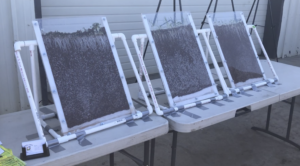
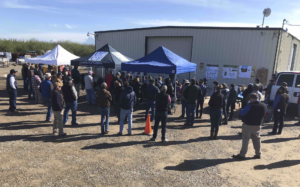
Other Cover Crop Field Days attended:
- 1 CAFF-RCD Orchard Cover Crop Field Day in Dixon, CA on 02/27/19: http://www.yolorcd.org/documents/CoverCropFieldDay_FlierFeb272019.pdf
- 1 NRCS Cover Crop Field Day in Lockeford, CA on 03/21/19: https://www.nrcs.usda.gov/wps/portal/nrcs/eventdetail/plantmaterials/newsroom/events/?cid=NRCSEPRD1445815
- 1 ANR Pomology meeting
